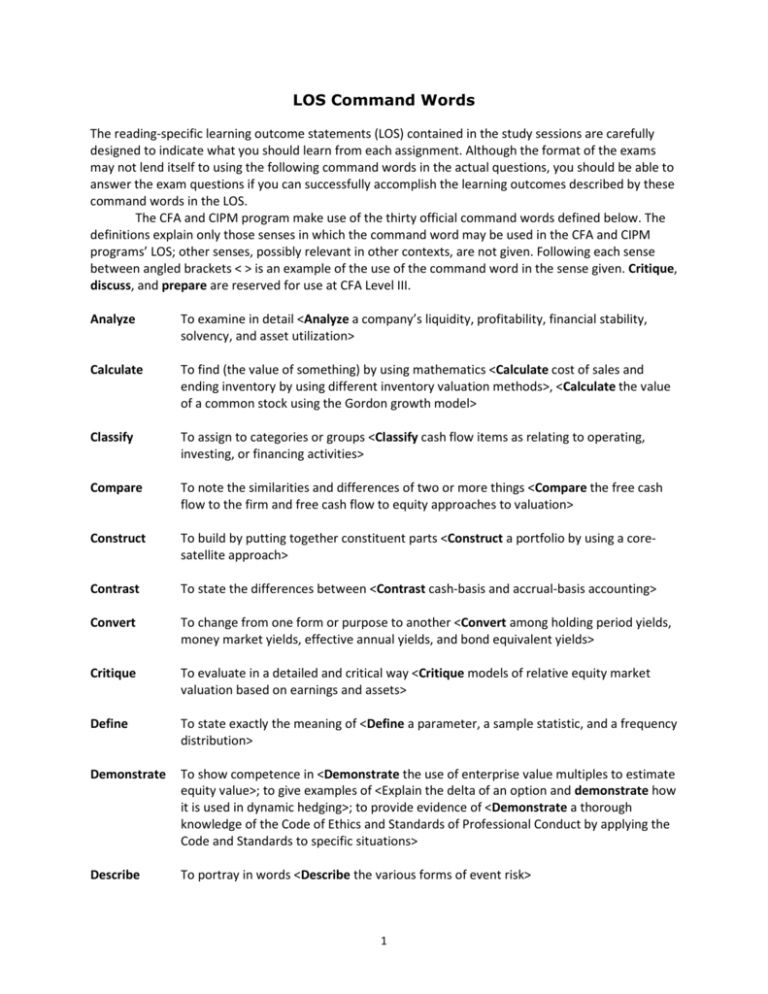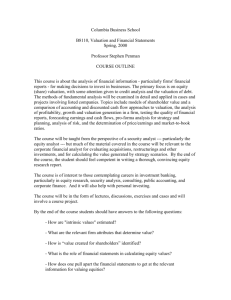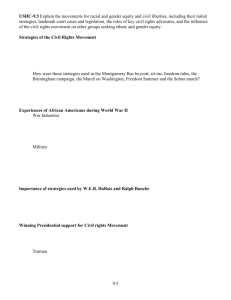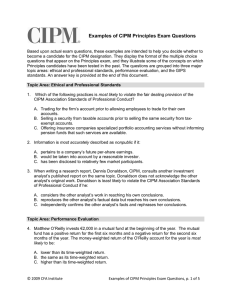LOS Command Words
advertisement

LOS Command Words The reading-specific learning outcome statements (LOS) contained in the study sessions are carefully designed to indicate what you should learn from each assignment. Although the format of the exams may not lend itself to using the following command words in the actual questions, you should be able to answer the exam questions if you can successfully accomplish the learning outcomes described by these command words in the LOS. The CFA and CIPM program make use of the thirty official command words defined below. The definitions explain only those senses in which the command word may be used in the CFA and CIPM programs’ LOS; other senses, possibly relevant in other contexts, are not given. Following each sense between angled brackets < > is an example of the use of the command word in the sense given. Critique, discuss, and prepare are reserved for use at CFA Level III. Analyze To examine in detail <Analyze a company’s liquidity, profitability, financial stability, solvency, and asset utilization> Calculate To find (the value of something) by using mathematics <Calculate cost of sales and ending inventory by using different inventory valuation methods>, <Calculate the value of a common stock using the Gordon growth model> Classify To assign to categories or groups <Classify cash flow items as relating to operating, investing, or financing activities> Compare To note the similarities and differences of two or more things <Compare the free cash flow to the firm and free cash flow to equity approaches to valuation> Construct To build by putting together constituent parts <Construct a portfolio by using a coresatellite approach> Contrast To state the differences between <Contrast cash-basis and accrual-basis accounting> Convert To change from one form or purpose to another <Convert among holding period yields, money market yields, effective annual yields, and bond equivalent yields> Critique To evaluate in a detailed and critical way <Critique models of relative equity market valuation based on earnings and assets> Define To state exactly the meaning of <Define a parameter, a sample statistic, and a frequency distribution> Demonstrate To show competence in <Demonstrate the use of enterprise value multiples to estimate equity value>; to give examples of <Explain the delta of an option and demonstrate how it is used in dynamic hedging>; to provide evidence of <Demonstrate a thorough knowledge of the Code of Ethics and Standards of Professional Conduct by applying the Code and Standards to specific situations> Describe To portray in words <Describe the various forms of event risk> 1 Determine To decide <Determine whether the nominal spread, zero-volatility spread, or optionadjusted spread should be used to evaluate a specific fixed-income security>; to ascertain <Determine the statistical significance of each independent variable> Discuss To examine critically and in detail <Discuss the impact that ability and willingness to take risk have on risk tolerance> Distinguish Point out differences between <Distinguish among empirical, subjective, and a priori probabilities> Estimate To determine an approximate value for <Estimate a company’s intrinsic value based on discounted cash flow analysis>; to reach an informed but possibly imprecise evaluation of <Estimate the impact of a change in accounting principle on a company’s reported financial statement> Evaluate To reach a conclusion or make a judgment about something through careful study <Evaluate the quality of a company’s financial data>, <Evaluate the appropriateness of using a particular rate of return as a discount rate>, <Evaluate a merger bid> Explain To make clear the meaning of <Explain interest rate parity> Forecast To estimate the future value of something <Forecast a company’s net income given sales projections by using a percentage-of-revenue approach>, <Forecast a company’s market share in different growth scenarios> Formulate To state in clear or definite form <Formulate a test of the hypothesis that the population correlation coefficient equals zero>; to devise <Formulate an appropriate response to actions that violate the Code of Ethics and Standards of Professional Conduct> Identify To recognize and correctly name <Identify and describe the desirable properties of an estimator>, <Identify the functions of a central bank> Interpret To give the meaning of <Interpret the estimated coefficients in a linear regression>, <Interpret the results of an equity style box analysis> Judge To form an opinion about through careful weighing of evidence <Judge whether an equity market is undervalued, fairly valued, or overvalued based on a relative equity valuation model> Justify To show to be valid or appropriate in a particular context <Justify the use of absolute performance and cash flow matching objectives to meet the goal of lifestyle protection> Prepare To put into written form <Prepare the constraints section of an investment policy statement for the Ingrams>, <Prepare an appropriate response for each of the four questions from the committee members> 2 Recommend To offer as being appropriate or good <Recommend practices and procedures designed to prevent violations of the Code of Ethics and Standards of Professional Conduct>, <Evaluate the choices of short-term funding available to a company and recommend a financing method> Select To choose as being the best or most suitable <Select an optimal portfolio by using Roy’s safety-first criterion> Show To communicate in writing <Show your work>; to make evident or clear <Show how positioning a company is a creative strategy for achieving a competitive advantage> Solve To find a solution for <Solve time value of money problems when compounding periods are other than annual> State To express in words <State the probability of an event in terms of odds for or against the event>; to provide <State the formula for the international capital asset pricing model> Support To provide corroboration for <Support each response with one reason based on Smith’s specific circumstances> 3











